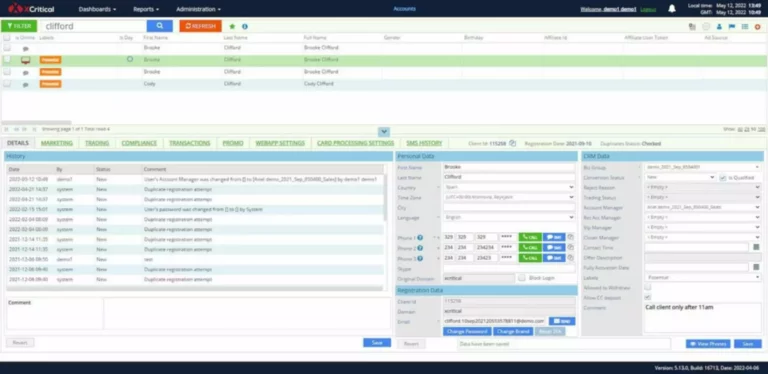Content
- Price/Time algorithm (or First-in-First-out)
- The dawn of a new era: AI’s transformative impact on business and society
- Matching engine round trip latency, staleness, and backtest event sequencing
- AI Trading Bot Outperforms Pros with $38,000 in a Week-Gain Amidst Global Stock Market Caution and Dollar Weakness
Due to this, the nature of the applications we build is optimised for low trust. Platforms like TikTok became https://www.xcritical.com/ popular because of how sticky they could make a content feed with the very small amount of information a user passes on to the platform. Too many advertisements, and users would not trust them any more than they trust Craigslist today. HashCash’s scalable solutions ensure seamless integration of trading business applications with the other Nasdaq business applications. Along with that, there are customized third-party business solutions and functionalities.
Price/Time algorithm (or First-in-First-out)
It is highly compatible with cryptocurrency activities and the retail forex market. Together, these components ensure that the order matching system operates smoothly and efficiently. Matching engines deploy different algorithms that crawl the order book to find Cryptocurrency and settle suitable requested trades. The cryptocurrency exchange matching engine is software that decentralised exchanges and brokerage companies use to fulfil market orders.
The dawn of a new era: AI’s transformative impact on business and society
Below is a flowchart that illustrates the crypto exchange matching engine control flow of the original program. EP3 can be deployed to cloud, hybrid-cloud, and on-premises environments. Limits the number of messages received per second from a market participant. Automatically cancel all orders of a market participant in the event of a FIX API’s disconnect. All working orders pertaining to a market participant can be canceled at once while preventing new ones.
- An order matching system or simply matching system is an electronic system that matches buy and sell orders for a stock market, commodity market or other financial exchanges.
- Together, these components ensure that the order matching system operates smoothly and efficiently.
- Latency – This factor is crucial for businesses, especially those deploying high-frequency trading strategies.
- For example, any hosting location in New York or New Jersey could be considered a proximity hosting site for Nasdaq, whose primary colocation is in Carteret.
- Think, for instance, of Google Maps—a large use case with no strong incumbents.
Matching engine round trip latency, staleness, and backtest event sequencing
This liquidity is essential for smooth market operations and can help to reduce price volatility. There are several types of order matching systems, each with its own set of rules and procedures for matching buy and sell orders. The two most common types are the price-time priority system and the pro-rata system. The Market Data Feed service offers the ability to receive real-time updates about the trading information such as quotes, last traded price, volumes and others. Common usages of this API include web-based trading systems (widgets like Watchlist or Market Depth) and public websites.
AI Trading Bot Outperforms Pros with $38,000 in a Week-Gain Amidst Global Stock Market Caution and Dollar Weakness
Integration with ForumMatch can be achieved through standard FIX and high-speed binary APIs with exchanges and trading venues usually having a test cycle of 1-2 months for a new project. The time for trading participants to connect can be hours to a matter of days depending on their own capabilities. Matching engines play a crucial role in facilitating efficient and timely order matching and trade execution in electronic exchanges.

If there are multiple orders of the same size, the order with the best price is given priority. If there are multiple orders with the same size and price, the orders are distributed proportionally. Validation of order quantities and prices to comply with min and max limits. Market participants are protected from entering an order with invalid quantities. Besides the fast and efficient characteristics of an engine, there are other features that you can explore to expand the functionality and usability of your platform. Note that the buyer’s and seller’s prices do not 100% match because the seller wants to sell at the highest possible price, while the buyer wants to purchase at the lowest possible price.
This basically means that the first order will be placed on top of the second order in the bid queue. Have you ever wondered how buy and sell orders magically turn into completed trades on stock or crypto exchanges? Well, the secret sauce behind this is something called a matching engine. The emergence of context at the periphery – through providers like Passport or Gitcoin – will soon enable a new generation of matching engines. And unlike DeFi or NFTs (which are huge on their own), this new generation of applications will potentially become what I consider ‘Internet-scale’. There will be a time when the use cases enabled by blockchain applications become relevant for the entirety of the web.
Right off the bat, it’s important to know which asset classes your trading venue will be offering. In this article, we’ll give you an insight into what an order matching engine is, the mechanics behind it, and what to pay attention to when choosing one for your exchange or dark pool. Implemented across a variety of international organizations, this module matches streaming music log files at a fraction of the cost and at multiple times the performance of other legacy systems. Latency – This factor is crucial for businesses, especially those deploying high-frequency trading strategies.
This development is coupled with advanced solutions that ensure the market stays efficient in light of the increasing number of traders. The order-matching engine is one of those innovations used to execute market orders, and many traders may not know that it exists. OMEs are crucial for efficient and accurate order matching, enabling buyers and sellers to trade without intermediaries and ensuring all trades are accomplished at the best possible price. Without them, human manual matching would be time-consuming and subject to human error. A trade matching mechanism compares buyers’ and sellers’ orders by considering their willingness to pay and the number of shares or financial instruments they are willing to trade. The engine searches for matches between orders and arranges trades based on these results.

This may seem far-fetched, but this version already exists within gaming today. Guilds like YGG are creating rich graphs consisting of users’ history on-chain. Game developers are incentivised to build for these users as they have rich, contextual data on their history. They could whitelist a handful of users who were early adopters of similar games and onboard them with incentives.
Nowadays exchange trading is almost fully enabled by intelligent matching engines. The order matching system is a fundamental component of modern trading operations. It is the engine that drives the financial markets, facilitating the buying and selling of securities by matching buy and sell orders. This system is responsible for ensuring that trades are executed efficiently and fairly, providing a transparent and reliable platform for traders. A cryptocurrency matching engine decides how you execute trades on your platform and how your business works. Major exchanges deploy one or more algorithms to find the best fit for their expectations and market conditions.
DXmatch ensures high-performance order matching with sub-100 microseconds latency. This level of speed allows for faster execution of trades, making it suitable for high-frequency trading strategies that require near-zero latency. Of course, there are multi-asset matching engines, like DXmatch, that are completely agnostic to the underlying assets they work with. That’s why they can be easily used on all conventional markets and even some unconventional ones, like prediction markets.
This may seem far-fetched, but consider that both Maple Finance and Goldfinch service this function for SMEs today. They have privately held context through the data they collect from the users. They tap into a publicly available pool of money to underwrite and execute their loans. Collecting user data directly and mapping it to anonymous interactions on-chain can build better applications.
As part of an exchange trading platform, a matching engine integrates with banks, payment institutions and liquidity providers via a low latency API. Due to improvements brought on by Hive, traders on Bitfinex now react more quickly to price movements and changing market conditions. The new architecture enables Bitfinex to maintain high performance in the face of a growing user base, new tradable assets and unforeseen spikes in trading activity.
As the crypto landscape continues to evolve, the role of matching engines will remain pivotal in ensuring the seamless execution of trades and maintaining the integrity of the trading ecosystem. A crypto matching engine is the core hardware and software component of any electronic exchange and trading platform. Its primary function is to match up the offers and bids for the completion of trading activity. Matching engines make use of one or more algorithms for allocation of trades among competing offers and bids of the same value. It is the heart of any electronic trading platform, ensuring that all trades are executed at the best possible prices and in a timely fashion. Our ForumMatch trading system with integral matching engine is suitable for exchanges, trading venues and marketplaces handling multiple asset classes.





